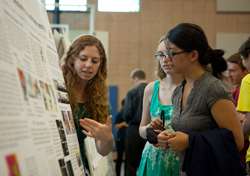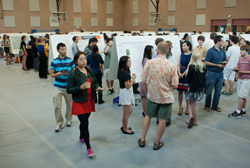Celebration Showcases Student Research
September 17, 2012About 150 students shared their scientific findings Sept. 11, during the Celebration of Summer Research at Harvey Mudd College.
 Among them was Sheena Patel ’14, whose basic physics research in potential magnetic storage systems caught the attention of physicists Stuart Parkin and Dan Dahlberg last July at the 19th International Conference on Magnetism in South Korea.
Among them was Sheena Patel ’14, whose basic physics research in potential magnetic storage systems caught the attention of physicists Stuart Parkin and Dan Dahlberg last July at the 19th International Conference on Magnetism in South Korea.
“It was intimidating and exciting, but to have those two so interested in my project shows that this research really means something,” Patel said of her encounter with the two physicists. “The work has been really challenging, but also rewarding, because I’m learning more about how things like hard drives work and where the research is headed.”
Patel worked with Stephen Ibanez ’15, Jennifer Sharma ’14, Christopher Sugino ’15, Christie Thompson ’15 and Yantao Wu ’15 on the summer project, entitled “Extraordinary Hall Measurements of Co/Ni Multilayers.”
Other projects highlighted at the annual celebration ranged from theoretical work to research that may benefit human health and energy production. Examples include:
Better Solar Cells
Students synthesized and measured the absorption and conductivity of porphyrin dyes—which convert photons from sunlight into electrons—to determine their potential use in dye-sensitized solar cells. The students’ research may lead to the future design of efficient, low-cost, flexible solar cells.
Lifesaving Algorithm
A student team analyzed data collected from buildings burned during fire training exercises and noted an increase in data slope just prior to structure collapse. They developed an algorithm designed to monitor sensor data and issue a warning. Once refined, it will aid in the development of an interactive device that could warn firefighters of an impending structure collapse and save lives.
Bacterial Biofilms
Students studied the evolution of genes that regulate the production of biofilms, which are slimy aggregations of bacterial cells. Their basic research with E. coli will help us better understand how bacteria evolve new traits, including those responsible for causing antibiotic resistance and human diseases.
The projects were part of HMC’s Summer Research Program, which engages students in 10 weeks of full-time research. About 200 HMC students pursued research projects this summer alongside 45 faculty members in biology, chemistry, computer science, engineering, mathematics and physics.

